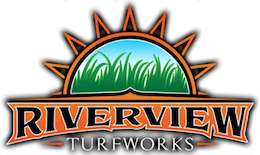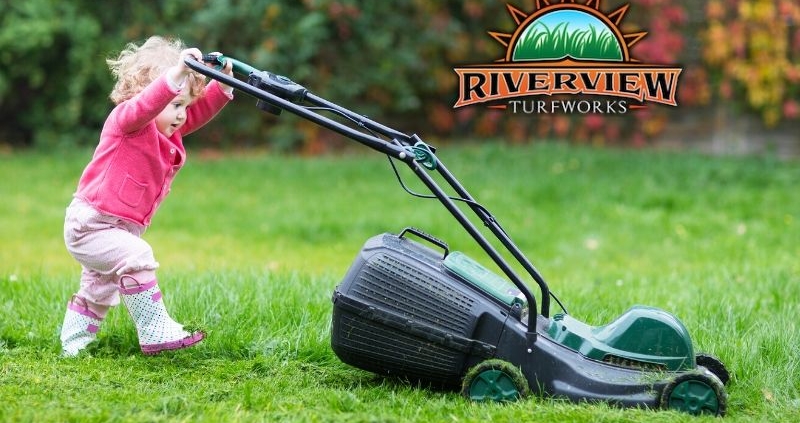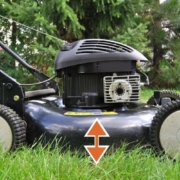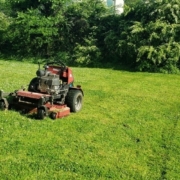How To Mow Your Lawn Like A Pro
[et_pb_section fb_built=”1″ _builder_version=”4.4.8″ custom_padding=”15px||15px||false|false”][et_pb_row _builder_version=”4.4.8″ width_tablet=”” width_phone=”95%” width_last_edited=”on|phone” custom_padding=”0px||0px|||”][et_pb_column type=”4_4″ _builder_version=”4.4.8″][et_pb_text _builder_version=”4.9.3″ header_2_font_size=”30px” header_2_line_height=”1.2em” header_3_font_size=”25px” header_3_line_height=”1.2em” hover_enabled=”0″ header_2_font_size_tablet=”26px” header_2_font_size_phone=”24px” header_2_font_size_last_edited=”on|phone” header_3_font_size_tablet=”22px” header_3_font_size_phone=”20px” header_3_font_size_last_edited=”on|phone” link_text_color=”#E95832″ sticky_enabled=”0″]
We hope you are ready to take your lawn mowing skills and knowledge to the next level!
In this Riverview Turfworks blog post, we will walk you through everything you need to know to mow your lawn like a true professional. We will cover all of the equipment you will need and the options you have. Then, quickly discuss some lawn maintenance best practices before diving into how lawn mowing professionals go about mowing a lawn.
And if for any reason you don’t want to mow your lawn yourself, you can always hire us! We mow residential lawns in Fort Smith, Van Buren, and Barling, AR.
[/et_pb_text][et_pb_text _builder_version=”4.4.9″ header_2_font_size=”30px” header_2_line_height=”1.2em” header_3_font_size=”25px” header_3_line_height=”1.2em” custom_margin=”||15px||false|false” header_2_font_size_tablet=”26px” header_2_font_size_phone=”24px” header_2_font_size_last_edited=”on|phone” header_3_font_size_tablet=”22px” header_3_font_size_phone=”20px” header_3_font_size_last_edited=”on|phone”]
Here is what you will learn about mowing in this article:
You can click on any link to skip to that portion of the post or continue scrolling down to learn everything you need to know to mow your lawn.
[/et_pb_text][et_pb_text _builder_version=”4.4.9″ link_font=”|700|||||||” header_2_font_size=”30px” header_2_line_height=”1.2em” header_3_font_size=”25px” header_3_line_height=”1.2em” header_2_font_size_tablet=”26px” header_2_font_size_phone=”24px” header_2_font_size_last_edited=”on|phone” header_3_font_size_tablet=”22px” header_3_font_size_phone=”20px” header_3_font_size_last_edited=”on|phone”]
- How to pick the right lawn equipment
- Consumabale lawn maintenance items
- Lawn mowing best practices
- Plan of attack for mowing the lawn
- Put your lawn mowing on cruise control
[/et_pb_text][/et_pb_column][/et_pb_row][/et_pb_section][et_pb_section fb_built=”1″ _builder_version=”4.4.8″ custom_padding=”0px||0px|||”][et_pb_row admin_label=”sect-1″ module_id=”sect-1″ _builder_version=”4.4.8″ width_tablet=”” width_phone=”95%” width_last_edited=”on|phone” custom_padding=”0px|||||”][et_pb_column type=”4_4″ _builder_version=”4.4.8″][et_pb_image src=”http://riverviewturfworks.com/wp-content/uploads/types-of-lawn-mowers.jpg” alt=”types of lawn mowers” title_text=”types of lawn mowers” align=”center” _builder_version=”4.4.9″][/et_pb_image][et_pb_text _builder_version=”4.4.9″ header_2_font_size=”30px” header_2_line_height=”1.2em” header_3_font_size=”25px” header_3_line_height=”1.2em” header_2_font_size_tablet=”26px” header_2_font_size_phone=”24px” header_2_font_size_last_edited=”on|phone” header_3_font_size_tablet=”22px” header_3_font_size_phone=”20px” header_3_font_size_last_edited=”on|phone”]
The options you have when it comes to lawn equipment
First things first, let’s nail down the essential lawn maintenance equipment needs. To mow your lawn like a pro you will at very least need a lawn mower, string trimmer (AKA weed eater), and a leaf blower. An optional piece of equipment you may want to consider is an edger. The edger is optional, because you can use your string trimmer to edge by flipping it on its side.
Let’s get you a little insight into all of the options available and pros and cons of each.
[/et_pb_text][et_pb_text _builder_version=”4.4.9″ header_2_font_size=”30px” header_2_line_height=”1.2em” header_3_font_size=”25px” header_3_line_height=”1.2em” header_2_font_size_tablet=”26px” header_2_font_size_phone=”24px” header_2_font_size_last_edited=”on|phone” header_3_font_size_tablet=”22px” header_3_font_size_phone=”20px” header_3_font_size_last_edited=”on|phone”]
Choosing the right lawn mower
You can break the types of lawn mowers available down into 4 broad types: push mowers, riding mowers, commercial mowers, and robotic mowers.
Pricing ranges from a hundred or so bucks for a push mower to $20k+ for a commercial-grade mower. There are many options available within each category and the different types of mowers are best suited for cutting certain types of lawns.
The lawn mower itself is the tool you will use to cut the majority of your grass.
[/et_pb_text][et_pb_text _builder_version=”4.4.9″ header_2_font_size=”30px” header_2_line_height=”1.2em” header_3_font_size=”25px” header_3_line_height=”1.2em” header_4_font_size=”20px” header_4_line_height=”1.2em” header_2_font_size_tablet=”26px” header_2_font_size_phone=”24px” header_2_font_size_last_edited=”on|phone” header_3_font_size_tablet=”22px” header_3_font_size_phone=”20px” header_3_font_size_last_edited=”on|phone”]
Push mowers
Push mowers are on the low end of the price range starting around $100 for a very basic model. If you want a self-propelled push mower you are looking upwards of $200 for a base model.
Push mowers are great for small lawns and are often the ideal mower for homeowners, especially in the River Valley where we operate our lawn maintenance business. Push mowers have the smallest deck size out of all the mower types. Typically push mowers have a cut width of 18-22″.
[/et_pb_text][et_pb_text _builder_version=”4.4.9″ header_2_font_size=”30px” header_2_line_height=”1.2em” header_3_font_size=”25px” header_3_line_height=”1.2em” header_4_font_size=”20px” header_4_line_height=”1.2em” header_2_font_size_tablet=”26px” header_2_font_size_phone=”24px” header_2_font_size_last_edited=”on|phone” header_3_font_size_tablet=”22px” header_3_font_size_phone=”20px” header_3_font_size_last_edited=”on|phone”]
Riding mowers
A riding mower is the ‘next step up’ if you will from a push mower. Riding mowers are hard to find for under $1k these days and make the experience a little more enjoyable when you mow your lawn.
Riding mowers are perfect for homeowners that live on a larger lot. Riding mowers can have cut widths as low as 30″ and can go up to 48″ or more. If your lawn has steep slopes, it may be dangerous to operate a riding mower on them. If your lawn does have steep areas, these may need to be mowed with a push mower or trimmed out with a string trimmer.
[/et_pb_text][et_pb_text _builder_version=”4.4.9″ header_2_font_size=”30px” header_2_line_height=”1.2em” header_3_font_size=”25px” header_3_line_height=”1.2em” header_4_font_size=”20px” header_4_line_height=”1.2em” header_2_font_size_tablet=”26px” header_2_font_size_phone=”24px” header_2_font_size_last_edited=”on|phone” header_3_font_size_tablet=”22px” header_3_font_size_phone=”20px” header_3_font_size_last_edited=”on|phone”]
Commercial grade mowers
This article wasn’t written for professionals but we did want it to be all-inclusive. Commercial lawn mowers start around $2k and go up from there. The average cost of a commercial lawn mower is $7k which may surprise some people.
Decks on commercial mowers range from 32″ to 72″ and larger on some recent new models. Commercial mowers come is a couple of different forms. They have walk-behind, stand-on, and zero turn models available. Each has its specific use case. We encourage you to Google these mowers if you are interested in learning more about them.
If you want to be as efficient as possible when you mow your lawn or want that professionally mowed look upon completion, a commercial mower is what you are looking for.
[/et_pb_text][et_pb_text _builder_version=”4.4.9″ header_2_font_size=”30px” header_2_line_height=”1.2em” header_3_font_size=”25px” header_3_line_height=”1.2em” header_4_font_size=”20px” header_4_line_height=”1.2em” header_2_font_size_tablet=”26px” header_2_font_size_phone=”24px” header_2_font_size_last_edited=”on|phone” header_3_font_size_tablet=”22px” header_3_font_size_phone=”20px” header_3_font_size_last_edited=”on|phone”]
Robotic mowers
The future of mowing is here! Kind of…
Robotic mowers are the new rave in the lawn and landscape world and have many lawn maintenance companies worried that they will make their jobs obsolete. Robotic mowers are still really in their infancy and still have a long way to go but there are plenty of working models available now. Like any new technology, the prices for robotic mowers are too expensive to really consider them a viable option at this time.
Once this technology improves a little, robotic mowers can literally mow your lawn for you.
[/et_pb_text][et_pb_text _builder_version=”4.4.9″ header_2_font_size=”30px” header_2_line_height=”1.2em” header_3_font_size=”25px” header_3_line_height=”1.2em” header_2_font_size_tablet=”26px” header_2_font_size_phone=”24px” header_2_font_size_last_edited=”on|phone” header_3_font_size_tablet=”22px” header_3_font_size_phone=”20px” header_3_font_size_last_edited=”on|phone”]
String trimmer and edger considerations
As lawn maintenance professionals, we are baffled at how many residential grade trimmers still come with a curved shaft. We highly recommend to purchase a string trimmer with a straight shaft and to make sure it can take at least .095 diameter trimmer line. We’ll touch more on trimmer line very soon.
String trimmers, also referred to as weed eaters or weed whips, allow you to trim down any grass the mower could not reach such as a fence line.
String trimmers can also be used to edge your concrete and other defined borders such as where your grass meets your landscape beds.
Edging refers to trimming the grass at a 90-degree angle perpendicular to the ground. This provides a professional, finished look. You can accomplish this using a string trimmer by simply flipping it on its side.
They do also make dedicated ‘lawn edgers’ if you find it to difficult to get the desired look with your string trimmer.
[/et_pb_text][et_pb_text _builder_version=”4.4.9″ header_2_font_size=”30px” header_2_line_height=”1.2em” header_3_font_size=”25px” header_3_line_height=”1.2em” header_2_font_size_tablet=”26px” header_2_font_size_phone=”24px” header_2_font_size_last_edited=”on|phone” header_3_font_size_tablet=”22px” header_3_font_size_phone=”20px” header_3_font_size_last_edited=”on|phone”]
Picking the right leaf blower
For most homeowners, a handheld leaf blower will provide you will plenty of power to blow off those grass clippings once your mowing, trimming, and edging are complete. If you need a little more power or know you will need to blow around a lot of leaves in the fall, you may want to consider a backpack leaf blower.
[/et_pb_text][/et_pb_column][/et_pb_row][et_pb_row admin_label=”sect-2″ module_id=”sect-2″ _builder_version=”4.4.8″ width_tablet=”” width_phone=”95%” width_last_edited=”on|phone” custom_padding=”0px|||||”][et_pb_column type=”4_4″ _builder_version=”4.4.8″][et_pb_image src=”http://riverviewturfworks.com/wp-content/uploads/Gas-battery-and-electric-powered.jpg” alt=”Gas battery and electric powered” title_text=”Gas battery and electric powered” align=”center” _builder_version=”4.4.9″][/et_pb_image][et_pb_text _builder_version=”4.4.9″ header_2_font_size=”30px” header_2_line_height=”1.2em” header_3_font_size=”25px” header_3_line_height=”1.2em” header_2_font_size_tablet=”26px” header_2_font_size_phone=”24px” header_2_font_size_last_edited=”on|phone” header_3_font_size_tablet=”22px” header_3_font_size_phone=”20px” header_3_font_size_last_edited=”on|phone”]
Gas, battery, or electric Lawn equipment?
To conclude the introduction to the lawn equipment, we wanted to let you know about the different power options you can choose from.
Gas-powered equipment is still the most common. Gas-powered equipment is very reliable and all you need to do is add more gas to keeping going. Plus, gas-powered equipment will provide you with more power than the other options which you may or may not need.
Battery-powered equipment is the new rave and there is plenty of reliable and powerful battery-powered equipment out there to pick from. We love the ‘green’ aspect of battery-powered equipment. The only real consideration here is to make sure the battery life of the equipment you pick has enough life to service your property.
Electric-powered equipment is yet another option. We can’t say we recommend electric-powered lawn equipment as they come with a cord that needs to be pulled in. This is not only a little dangerous but also limits your range.
[/et_pb_text][et_pb_image src=”http://riverviewturfworks.com/wp-content/uploads/Lawn-mower-replacement-parts.jpg” alt=”Lawn mower replacement parts” title_text=”Lawn mower replacement parts” align=”center” _builder_version=”4.4.9″][/et_pb_image][et_pb_text _builder_version=”4.4.9″ header_2_font_size=”30px” header_2_line_height=”1.2em” header_3_font_size=”25px” header_3_line_height=”1.2em” header_2_font_size_tablet=”26px” header_2_font_size_phone=”24px” header_2_font_size_last_edited=”on|phone” header_3_font_size_tablet=”22px” header_3_font_size_phone=”20px” header_3_font_size_last_edited=”on|phone”]
Consumable items needed to mow your lawn
Maintaining your lawn comes with needing to stay on top of the consumable items to make sure you have everything you need to complete the task. Let’s go over a handful of the items we thought were most important.
We love supporting local businesses, but if you aren’t sure where to go for replacement parts and consumable items, we recommend checking out iGoPro Lawn Supply.
[/et_pb_text][et_pb_text _builder_version=”4.4.9″ header_2_font_size=”30px” header_2_line_height=”1.2em” header_3_font_size=”25px” header_3_line_height=”1.2em” header_2_font_size_tablet=”26px” header_2_font_size_phone=”24px” header_2_font_size_last_edited=”on|phone” header_3_font_size_tablet=”22px” header_3_font_size_phone=”20px” header_3_font_size_last_edited=”on|phone”]
Replacement parts and supplies
No matter how careful you are with your equipment, eventually, something will break or fail and need to be replaced. With the robust library of videos on YouTube, a quick search would probably enable you to perform the repair or maintenance task yourself, or you can take it to a local small engine repair shop.
There is no way for us to know what you may need to replace, but more than likely iGoPro Lawn Supply has it. They have over 9,000 lawn parts and supplies ready to ship your way.
When it comes to your maintenance needs, eventually you will need to purchase items like spark plugs, oil, oil filters, and air filters and possibly other items such as fuel filters or carburetors.
[/et_pb_text][et_pb_text _builder_version=”4.4.9″ header_2_font_size=”30px” header_2_line_height=”1.2em” header_3_font_size=”25px” header_3_line_height=”1.2em” header_2_font_size_tablet=”26px” header_2_font_size_phone=”24px” header_2_font_size_last_edited=”on|phone” header_3_font_size_tablet=”22px” header_3_font_size_phone=”20px” header_3_font_size_last_edited=”on|phone”]
The different types of lawn mower blades
Your lawn mower probably came with standard lawn mowing blades which is usually just fine for most use cases. If you are not happy with the look of your lawn after mowing it, we have a couple of things you may want to try as far as the blades go.
2 other types of lawn mower blades are high-lift blades and mulching blades. High-lift mower blades will create ‘more lift’ which sucks the grass up with more force, creating a more even finished cut height. If your lawn is looking uneven after mowing, replacing your current mower’s blades with high-lift blades could very well be the solution.
Mulching blades are perfect for shredding leaves for example. They also shred longer blades of grass while still contained within the mower deck. If you are noticing a lot of grass clippings and other lawn debris on top of your lawn after mowing, mulching blades may be the solution for that.
[/et_pb_text][et_pb_text _builder_version=”4.4.9″ header_2_font_size=”30px” header_2_line_height=”1.2em” header_3_font_size=”25px” header_3_line_height=”1.2em” header_2_font_size_tablet=”26px” header_2_font_size_phone=”24px” header_2_font_size_last_edited=”on|phone” header_3_font_size_tablet=”22px” header_3_font_size_phone=”20px” header_3_font_size_last_edited=”on|phone”]
Buy the right trimmer string
Not all trimmer string is created equal!
We mentioned .095 trimmer line earlier. This is the minimum diameter we recommend for use in a string trimmer. Some residential-grade string trimmers will not accept .095 line, so this is something you would need to know before purchasing that item!
The reason is your trimmer string is going to hit things like concrete and brick. If your line is a smaller diameter than .095, it will wear quickly and need to be ‘tapped out’ and replaced often. ‘Tapped out’ just refers to how most string trimmer releases more string when you tap them on the ground.
[/et_pb_text][/et_pb_column][/et_pb_row][et_pb_row admin_label=”sect-3″ module_id=”sect-3″ _builder_version=”4.4.8″ width_tablet=”” width_phone=”95%” width_last_edited=”on|phone” custom_padding=”0px|||||”][et_pb_column type=”4_4″ _builder_version=”4.4.8″][et_pb_image src=”http://riverviewturfworks.com/wp-content/uploads/Mower-maintenance.jpg” alt=”Mower maintenance” title_text=”Mower maintenance” align=”center” _builder_version=”4.4.9″][/et_pb_image][et_pb_text _builder_version=”4.4.9″ header_2_font_size=”30px” header_2_line_height=”1.2em” header_3_font_size=”25px” header_3_line_height=”1.2em” header_2_font_size_tablet=”26px” header_2_font_size_phone=”24px” header_2_font_size_last_edited=”on|phone” header_3_font_size_tablet=”22px” header_3_font_size_phone=”20px” header_3_font_size_last_edited=”on|phone”]
Things you should know before mowing your lawn
We are almost to the action steps of actually mowing your lawn! Before we get to that, let’s cover a couple of things you really should know before you ever cut grass.
[/et_pb_text][et_pb_text _builder_version=”4.4.9″ header_2_font_size=”30px” header_2_line_height=”1.2em” header_3_font_size=”25px” header_3_line_height=”1.2em” header_2_font_size_tablet=”26px” header_2_font_size_phone=”24px” header_2_font_size_last_edited=”on|phone” header_3_font_size_tablet=”22px” header_3_font_size_phone=”20px” header_3_font_size_last_edited=”on|phone”]
Lawn equipment maintenance
Maintaining your lawn equipment is no joke. Failing to do so can get expensive very quickly. Most of these to-dos apply to gas engine equipment, but it is always a good idea to give any piece of equipment a good once-over from time to time to ensure no bolts have fallen out or became loose.
Be prepared to change oil and replace the oil filter. Other filters that may need to be replaced periodically on your mower include air filters, fuel filters, and hydro filters.
Spark plugs will need to be replaced every couple of years.
Some mowers require greasing of the grease fittings. It is as simple as connecting a grease gun and giving it a couple of pumps until you see the grease start to escape from the seals.
You should also drain the gas from your equipment before extended periods of downtime such as over the winter months. All you need to do here is to dump or siphon the gas out back into a can, then run that piece of equipment until it completely drains the carburetor of gas.
[/et_pb_text][/et_pb_column][/et_pb_row][et_pb_row admin_label=”sect-4″ module_id=”sect-4″ _builder_version=”4.4.8″ width_tablet=”” width_phone=”95%” width_last_edited=”on|phone” custom_padding=”0px|||||”][et_pb_column type=”4_4″ _builder_version=”4.4.8″][et_pb_text _builder_version=”4.4.9″ header_2_font_size=”30px” header_2_line_height=”1.2em” header_3_font_size=”25px” header_3_line_height=”1.2em” header_4_font_size=”20px” header_4_line_height=”1.2em” header_2_font_size_tablet=”26px” header_2_font_size_phone=”24px” header_2_font_size_last_edited=”on|phone” header_3_font_size_tablet=”22px” header_3_font_size_phone=”20px” header_3_font_size_last_edited=”on|phone”]
Keep your mower blades sharp
You do want to cut your grass, not tear it, right? Well, if you didn’t know that before, now you do. If your blades are dull they will tear the grass instead of cutting it cleanly. It doesn’t sound like that big of a deal but it puts additional stress on your mower, is bad for the health of the grass, and can really look terrible.
We’ve seen lawns that looked like they had a dusting of snow on them simply because the tips of the grass turned white where the blades tore them instead of cut them.
[/et_pb_text][et_pb_text _builder_version=”4.4.9″ header_2_font_size=”30px” header_2_line_height=”1.2em” header_3_font_size=”25px” header_3_line_height=”1.2em” header_4_font_size=”20px” header_4_line_height=”1.2em” header_2_font_size_tablet=”26px” header_2_font_size_phone=”24px” header_2_font_size_last_edited=”on|phone” header_3_font_size_tablet=”22px” header_3_font_size_phone=”20px” header_3_font_size_last_edited=”on|phone”]
Scrape the underside of your mower’s deck
Another thing you should do often is scraping the bottom of your mower deck. This goes back to the comments about ‘lift’ earlier. Grass clippings tend to build-up on the underside of your lawnmowers deck, especially when mowing weedy or wet grass. You can take any tool you have laying around to scrape around and remove that build-up.
[/et_pb_text][et_pb_text _builder_version=”4.4.9″ header_2_font_size=”30px” header_2_line_height=”1.2em” header_3_font_size=”25px” header_3_line_height=”1.2em” header_2_font_size_tablet=”26px” header_2_font_size_phone=”24px” header_2_font_size_last_edited=”on|phone” header_3_font_size_tablet=”22px” header_3_font_size_phone=”20px” header_3_font_size_last_edited=”on|phone”]
Only mow 1/3 of the grass blade off at a time
You have got to stay on top of your mowing schedule! Letting your lawn get lawn is not healthy for your turf plus it becomes a lot harder and more time consuming to mow. In a perfect world, you should never remove more than 1/3 of the grass blades length per mowing. This also greatly reduces the chances of clippings being visible on top of your lawn after mowing.
If you do notice grassing clippings laying on top of your lawn after you mow your lawn, try taking your leaf blower and dispersing those clippings until they fall into the lawn. If there are too many, raking and bagging them may be your only solution.
[/et_pb_text][et_pb_text _builder_version=”4.4.9″ header_2_font_size=”30px” header_2_line_height=”1.2em” header_3_font_size=”25px” header_3_line_height=”1.2em” header_2_font_size_tablet=”26px” header_2_font_size_phone=”24px” header_2_font_size_last_edited=”on|phone” header_3_font_size_tablet=”22px” header_3_font_size_phone=”20px” header_3_font_size_last_edited=”on|phone”]
Your ‘cut height’ makes a difference
If you are wondering why the lawns surrounding yours are a little greener, the cut height could be the reason. There are plenty of other reasons, but this is a good place to start. The grass blades literally shade the soil surface beneath. Even raising your mower’s deck 1/2″ can make a big difference in the amount of moisture that is retained in the soil and your lawn will thank you!
[/et_pb_text][et_pb_image src=”http://riverviewturfworks.com/wp-content/uploads/How-to-mow-a-lawn.jpg” alt=”How to mow a lawn” title_text=”How to mow a lawn” align=”center” _builder_version=”4.4.9″][/et_pb_image][et_pb_text _builder_version=”4.4.9″ header_2_font_size=”30px” header_2_line_height=”1.2em” header_3_font_size=”25px” header_3_line_height=”1.2em” header_2_font_size_tablet=”26px” header_2_font_size_phone=”24px” header_2_font_size_last_edited=”on|phone” header_3_font_size_tablet=”22px” header_3_font_size_phone=”20px” header_3_font_size_last_edited=”on|phone”]
Mowing the lawn: Step by step
It’s time to snap into action, get out there, and start mowing!
Lawn professionals make money by performing the services they offer in an efficient manner. It helps that most lawn pros have commercial-grade equipment which just adds to their efficiency.
But, we’d love to share with you our thought process on how we go about mowing a lawn.
[/et_pb_text][et_pb_text _builder_version=”4.4.9″ header_2_font_size=”30px” header_2_line_height=”1.2em” header_3_font_size=”25px” header_3_line_height=”1.2em” header_2_font_size_tablet=”26px” header_2_font_size_phone=”24px” header_2_font_size_last_edited=”on|phone” header_3_font_size_tablet=”22px” header_3_font_size_phone=”20px” header_3_font_size_last_edited=”on|phone”]
Have a system for mowing your lawn
All you have to do is fire up that mower and start pushing it around, right? We guess that is technically right, but let’s make a game plan.
Professionals usually start off mowing the lawn before trimming or edging. The reason behind this is because by mowing first, you will then know exactly what needs to be trimmed, it will be the only tall grass left. If you trim first, you are more than likely going to spend a little more time than needed trimming because there is a little guesswork involved.
Make perimeter passes around everything 2-3 times blowing the grass clippings away from obstacles. Pros start mowing by outlining the property’s edges and obstacles. This gets all the tall grass away from items like siding, mulch beds, and everything else you don’t want to be plastered with grass clippings. It also gives you a place to turn your mower.
After the perimeter passes are complete, its time to section of your lawn and start going back and forth until that section is complete. Professionals call this ‘striping a lawn.’ Move on to the next section and repeat until the entire lawn has been mowed.
[/et_pb_text][et_pb_text _builder_version=”4.4.9″ header_2_font_size=”30px” header_2_line_height=”1.2em” header_3_font_size=”25px” header_3_line_height=”1.2em” header_4_font_size=”20px” header_4_line_height=”1.2em” header_2_font_size_tablet=”26px” header_2_font_size_phone=”24px” header_2_font_size_last_edited=”on|phone” header_3_font_size_tablet=”22px” header_3_font_size_phone=”20px” header_3_font_size_last_edited=”on|phone”]
To bag or not to bag?
That is a common question many homeowners have. The answer depends, but typically it is ideal to return the clippings to the lawn instead of bagging them.
Grass clippings break down over time and offer natural fertilization to your lawn. If your grass has gotten long or you are experiencing a lot of thatch build-up on your soil surface, consider bagging under those circumstances.
[/et_pb_text][et_pb_text _builder_version=”4.4.9″ header_2_font_size=”30px” header_2_line_height=”1.2em” header_3_font_size=”25px” header_3_line_height=”1.2em” header_2_font_size_tablet=”26px” header_2_font_size_phone=”24px” header_2_font_size_last_edited=”on|phone” header_3_font_size_tablet=”22px” header_3_font_size_phone=”20px” header_3_font_size_last_edited=”on|phone”]
Trim and edge your lawn efficiently
The whole concept here is to not walk back and forth to trim obstacles that are near each other more than once.
We like to start on the right-hand side of the front lawn by the street and trim and edge our way around the entire property in one fail swoop ending on the left-hand side of the front lawn by the street. Most pros do use their string trimmers to edge because it is more efficient and doesn’t require the purchase and upkeep of an additional piece of equipment.
If you do have a dedicated edger you would like to use, you can apply this same concept for each task, trimming and edging separately.
[/et_pb_text][et_pb_text _builder_version=”4.4.9″ header_2_font_size=”30px” header_2_line_height=”1.2em” header_3_font_size=”25px” header_3_line_height=”1.2em” header_2_font_size_tablet=”26px” header_2_font_size_phone=”24px” header_2_font_size_last_edited=”on|phone” header_3_font_size_tablet=”22px” header_3_font_size_phone=”20px” header_3_font_size_last_edited=”on|phone”]
Blowing off the grass clippings
Our advice when blowing is to start blowing on the street back towards your lawn. Please don’t be one of those people who insist on blowing their grass clippings out into the street! This not only looks horrible but is very dangerous for motorcyclists.
So, it goes, blow off the street first, then the sidewalk if applicable, and work your way up the driveway blowing off the grass clippings as you go. Then go around one side of the house to blow clippings off any paved areas in the back and come back around the other side of the house to ensure you have blown the clippings off all of the paved surfaces.
A pro tip is to check mulch beds and fence lines or foundations for grass clipping build-up as you go. If you notice clippings building up in these areas, blow them around as you are making your way around your property.
[/et_pb_text][/et_pb_column][/et_pb_row][et_pb_row admin_label=”sect-5″ module_id=”sect-5″ _builder_version=”4.4.8″ width_tablet=”” width_phone=”95%” width_last_edited=”on|phone” custom_padding=”0px|||||”][et_pb_column type=”4_4″ _builder_version=”4.4.8″][et_pb_image src=”http://riverviewturfworks.com/wp-content/uploads/Riverview-Turfworks-lawn-mowing-service.jpg” alt=”Riverview Turfworks lawn mowing service” title_text=”Riverview Turfworks lawn mowing service” align=”center” _builder_version=”4.4.9″][/et_pb_image][et_pb_text _builder_version=”4.9.3″ link_font=”|600|||||||” link_text_color=”#E95832″ header_2_font_size=”30px” header_2_line_height=”1.2em” header_3_font_size=”25px” header_3_line_height=”1.2em” header_2_font_size_tablet=”26px” header_2_font_size_phone=”24px” header_2_font_size_last_edited=”on|phone” header_3_font_size_tablet=”22px” header_3_font_size_phone=”20px” header_3_font_size_last_edited=”on|phone”]
Hire us to mow your lawn
If you are completely overwhelmed at this point, you are still in luck! We would love to mow your lawn for you! That is what we do all day, every day for your friends and neighbors anyway. We’d be more than happy to add your lawn to our schedule.
What did you think? Did you learn something about mowing? Do you think a friend would enjoy this tutorial? Please feel free to contact us or share this with a friend or on social media.
We hope to hear from you soon. Happy mowing!
[/et_pb_text][/et_pb_column][/et_pb_row][/et_pb_section]








